Football is a high-energy contact sport, which means that injuries on the pitch are common. To ensure the safety of players, it’s important to have a well-stocked first aid kit specifically designed for football. The kit should contain essential items such as wound dressings, bandages, plasters, tape, gloves, tweezers, scissors, safety pins, wipes, a foil blanket, and an instant ice pack. Additionally, including items like a first aid guide, different sizes of bandages and dressings, wound closures, zinc oxide tape, elastic adhesive bandages, gauze swabs, a clinical waste bag, and antiseptic cream can be useful.
Common football injuries include concussion, sprains, strains, fractures, and cuts. To prevent these injuries, players should always complete a proper warm-up and cool-down routine before and after matches. This helps prepare the body for physical activity and reduces the risk of strains and sprains. It’s also important for coaches to educate themselves and their teams on injury prevention and basic first aid techniques.
Regularly checking and replenishing the first aid kit is crucial to ensure that all supplies are up to date and readily available. Coaches should also consider customizing the kit based on the specific needs and requirements of the team, taking into account individual player medical conditions and preferences. Keeping the first aid kit easily accessible during practices and games is essential, as quick access to medical supplies can make a significant difference in managing injuries effectively.
By investing in a well-stocked first aid kit and prioritizing safety, coaches can help address and prevent common football injuries. Player safety should always be the top priority, and having the right medical supplies at hand is an important step towards ensuring the well-being of all players on the field.
Football players are prone to a range of injuries, including concussions, sprains, strains, fractures, and cuts. Understanding these common football injuries is essential for effective injury prevention and treatment.
Concussions are a serious concern in football, often resulting from high-impact collisions or falls. Players should be educated on the signs and symptoms of concussions and should never continue playing if they suspect a head injury.
Sprains and strains are also prevalent in football, typically affecting the ankles, knees, and wrists. Proper warm-up exercises and stretching routines before matches can help prevent these types of injuries. In the event of a sprain or strain, immediate treatment and proper rehabilitation are crucial for a speedy recovery.
Fractures, such as broken bones, can occur due to direct impact or excessive force on a specific area. These injuries often require medical attention and may result in a player being sidelined for an extended period. Cuts and wounds are common due to the physical nature of the sport. It is important to clean and dress these injuries promptly to prevent infection.
Common Football Injuries
Football players are prone to a range of injuries, including concussions, sprains, strains, fractures, and cuts. Understanding these common football injuries is essential for effective injury prevention and treatment.
| Injury | Description | Treatment |
|---|---|---|
| Concussion | A traumatic brain injury caused by a blow to the head. | Immediate removal from play, medical evaluation, rest, and gradual return to activity. |
| Sprains and Strains | Sprains are ligament injuries, while strains are muscle or tendon injuries. | RICE method (Rest, Ice, Compression, Elevation), rehabilitation exercises, and gradual return to play. |
| Fractures | A broken bone caused by trauma or excessive force. | Medical evaluation, immobilization, and potential surgery followed by rehabilitation. |
| Cuts and Wounds | Lacerations or open wounds caused by contact or sharp objects. | Clean the wound, apply a dressing, and seek medical attention if necessary. |
Prevention is key to reducing the risk of these injuries. Players should prioritize proper warm-up and cool-down routines, wear appropriate protective gear, and follow safety guidelines. Coaches and teams should promote player safety, educate themselves on injury prevention and basic first aid techniques, and ensure that a well-stocked first aid kit is easily accessible during practices and games.

Warming up and cooling down before and after football matches play a crucial role in injury prevention and overall player safety. These exercises are essential for preparing the body for physical activity and aiding in recovery. By incorporating a proper warm-up and cool-down routine into their training sessions, football players can reduce the risk of injuries and optimize their performance on the pitch.
During warm-up, players engage in light aerobic exercises, such as jogging or cycling, to raise their heart rate and increase blood flow to the muscles. This helps to loosen up the muscles and joints, making them more flexible and ready for the demands of the game. It also activates the nervous system, enhancing coordination and reaction time. Additionally, warm-up exercises gradually increase the workload on the cardiovascular system, preventing sudden spikes in heart rate or blood pressure during the game.
Cooling down after a football match is just as important as warming up. It allows the body to gradually return to its resting state, preventing the pooling of blood in the extremities and reducing the risk of dizziness or fainting. Cooling down helps to remove waste products, such as lactic acid, from the muscles, reducing muscle soreness and promoting faster recovery. It also allows the heart rate to gradually return to its baseline, preventing abrupt changes in blood pressure and minimizing the risk of cardiovascular complications.
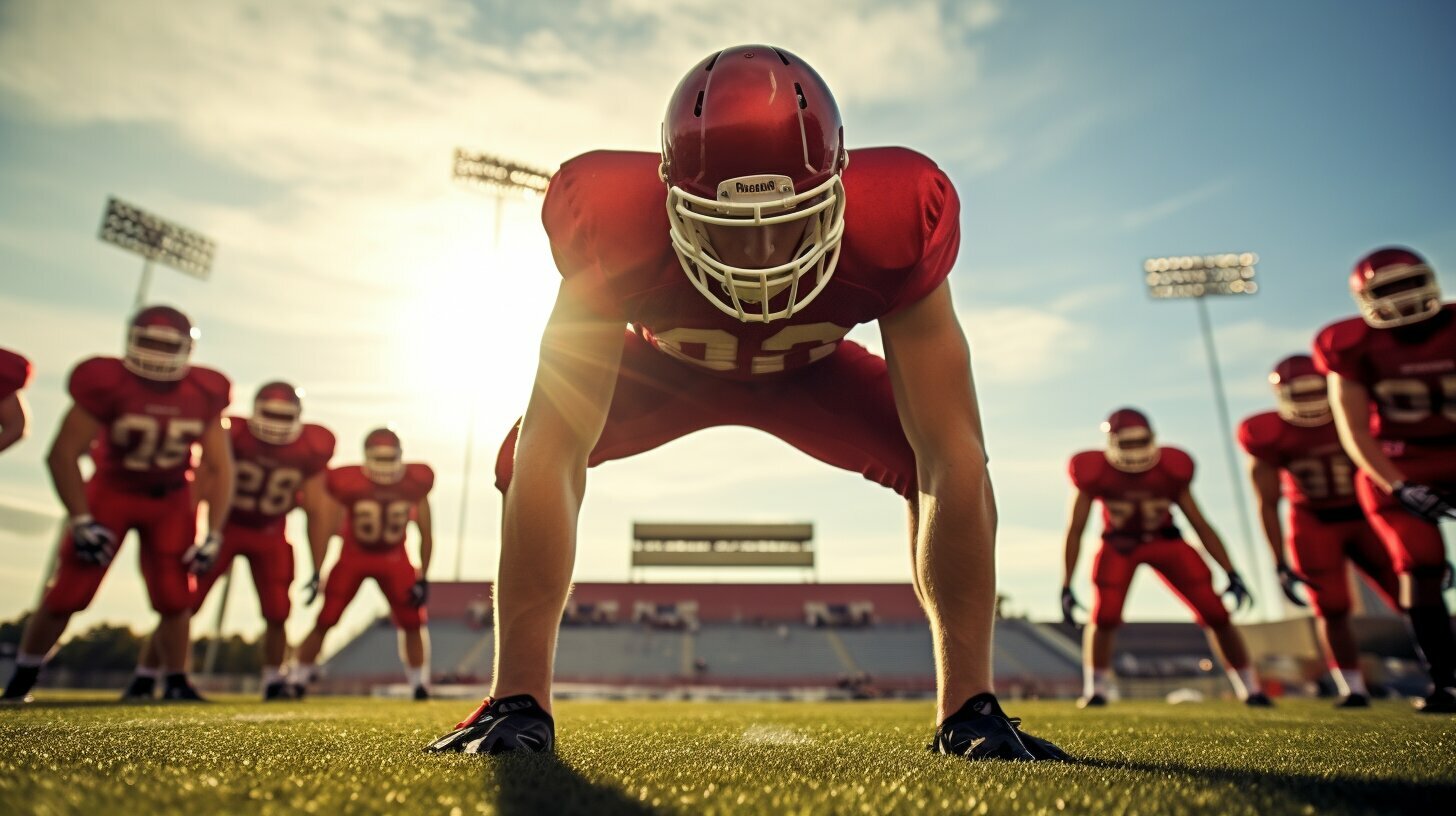
| Benefits of Warm-up: | Benefits of Cool-down: |
|---|---|
|
|
Essential Items for a Football First Aid Kit
A well-stocked football first aid kit should include essential items such as wound dressings, bandages, plasters, tape, gloves, tweezers, scissors, safety pins, wipes, foil blanket, and an instant ice pack. These supplies are crucial for treating common football injuries and ensuring the safety of players on the pitch.

To effectively manage injuries, it is important to have a variety of wound dressings in your first aid kit. These can include sterile gauze pads, adhesive bandages, and adhesive tape to secure the dressings. Bandages, such as elastic bandages and crepe bandages, are essential for providing support and compression for sprains and strains.
Tweezers and scissors are necessary tools for removing splinters, cutting tape and dressings, while gloves and safety pins ensure a hygienic and secure application of first aid materials. Wipes and antiseptic cream help clean and disinfect wounds, preventing infection.
Lastly, an instant ice pack provides immediate cooling to reduce swelling and pain associated with injuries, while a foil blanket can help regulate body temperature and provide comfort for injured players.
| Essential Items for a Football First Aid Kit | |
|---|---|
| Wound dressings | Gauze pads, adhesive bandages |
| Bandages | Elastic bandages, crepe bandages |
| Plasters | Adhesive bandages |
| Tape | Adhesive tape |
| Gloves | Disposable gloves |
| Tweezers | For splinter removal |
| Scissors | For cutting tape and dressings |
| Safety pins | Secure bandages and dressings |
| Wipes | Cleansing wipes |
| Foil blanket | For regulating body temperature |
| Instant ice pack | For immediate cooling |
Summary:
A well-stocked football first aid kit should include essential items such as wound dressings, bandages, plasters, tape, gloves, tweezers, scissors, safety pins, wipes, foil blanket, and an instant ice pack. These supplies ensure that players receive prompt and appropriate treatment for common injuries on the pitch. By having these sports first aid essentials readily available, coaches and medical staff can effectively address football injuries and prioritize player safety.
Additional Items for a Football First Aid Kit
In addition to the essential items, there are several other supplies that can enhance a football first aid kit. These additional items can be helpful in providing comprehensive care for common football injuries. Here are some recommended additions to consider:
- A first aid guide: A comprehensive guide that provides instructions on how to administer basic first aid for different types of injuries. It can be a valuable resource for coaches and team members.
- Various sizes of bandages and dressings: Including different sizes of bandages and dressings ensures that you have the right supplies to manage various types of cuts, wounds, and injuries.
- Wound closures: Adhesive wound closures, such as butterfly closures, can be used to secure cuts and lacerations that are difficult to bandage.
- Zinc oxide tape: This strong, adhesive tape is ideal for stabilizing joints and providing support for sprains and strains.
- Elastic adhesive bandages: Elastic adhesive bandages, commonly known as elastic wraps or athletic tape, are useful for compression and support of joints, as well as securing dressings.
- Gauze swabs: Gauze swabs can be used for cleaning wounds, applying antiseptic creams, or as a padding for larger injuries.
- A clinical waste bag: It’s important to have a designated bag for the disposal of medical waste, such as used gloves, dressings, and wipes.
- Antiseptic cream: An antiseptic cream can help prevent infection in minor cuts and wounds. Make sure to choose a cream that is suitable for football-related injuries.
By including these additional supplies in your football first aid kit, you can be better prepared to handle a wide range of injuries that may occur on the pitch. It’s essential to regularly check and replenish your kit to ensure all supplies are available and in proper condition.
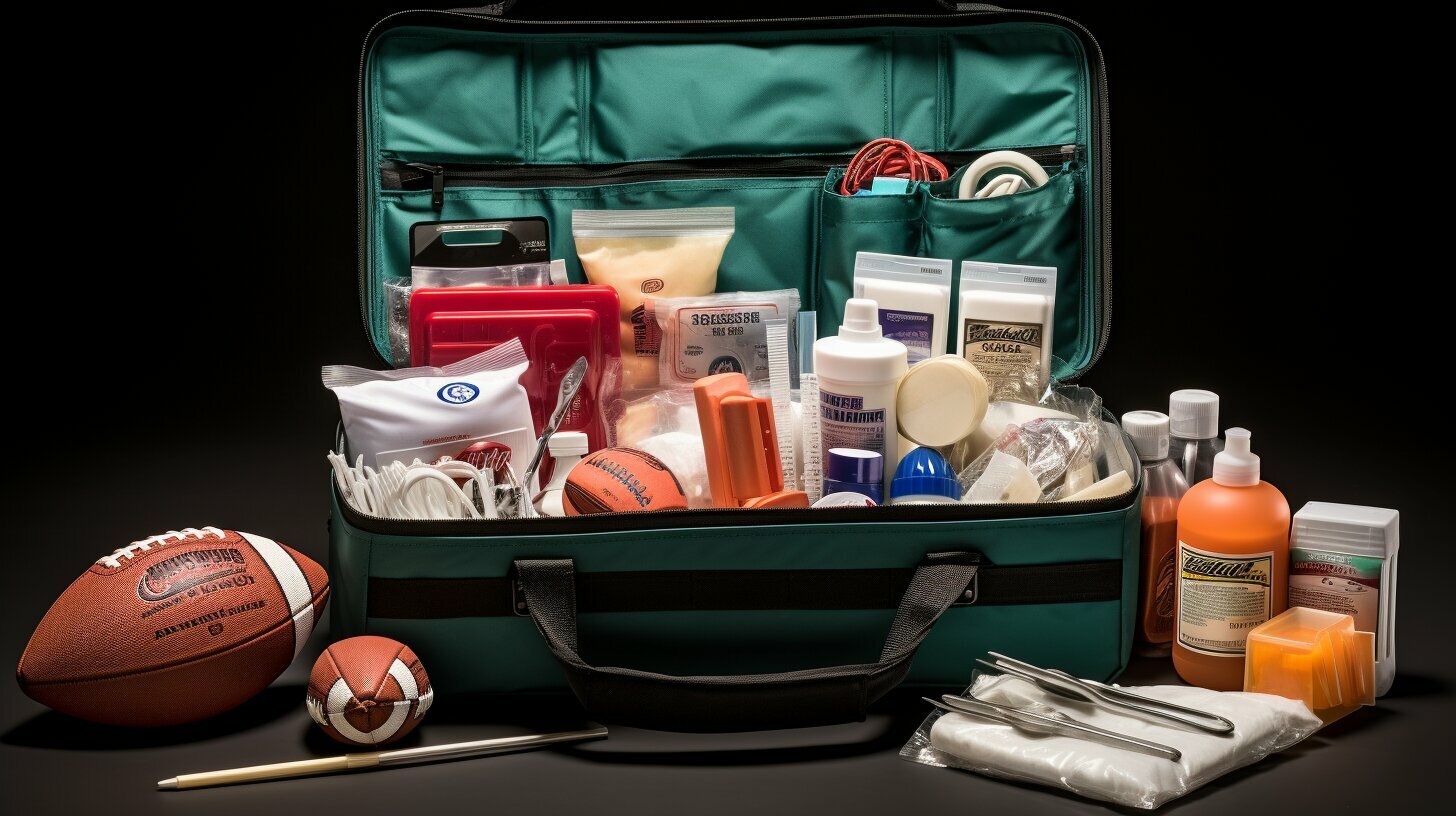
| Item | Quantity |
|---|---|
| Wound dressings | 10 |
| Bandages | 10 |
| Plasters | 20 |
| Tape | 2 rolls |
| Gloves | 10 pairs |
| Tweezers | 1 |
| Scissors | 1 |
| Safety pins | 10 |
| Wipes | 20 |
| Foil blanket | 1 |
| Instant ice pack | 2 |
| First aid guide | 1 |
| Various sizes of bandages and dressings | As needed |
| Wound closures | 10 |
| Zinc oxide tape | 2 rolls |
| Elastic adhesive bandages | 3 rolls |
| Gauze swabs | 10 |
| Clinical waste bag | 1 |
| Antiseptic cream | 1 tube |
Educating Coaches and Team on Injury Prevention and First Aid
Coaches have a vital role to play in promoting player safety by educating themselves and their teams on injury prevention strategies and basic first aid techniques. By equipping coaches with the knowledge and tools they need, we can create a safer environment for football players of all ages.
One of the first steps in educating coaches and teams is to emphasize the importance of injury prevention. Coaches should understand the common football injuries and the factors that contribute to them. This knowledge will help them implement strategies to minimize the risks during training sessions and matches. It’s crucial to educate players on proper techniques for tackling, heading, and landing to reduce the likelihood of injuries.
Basic first aid training is also essential for coaches. They should know how to recognize and respond to common football injuries, such as sprains, strains, and concussions. In the event of an injury, coaches should be able to provide immediate care and make informed decisions about when to seek medical attention.
To further enhance safety on the field, coaches should encourage players to adopt good habits. This includes emphasizing the importance of warm-up and cool-down exercises before and after matches, as they can help prevent injuries. Coaches should also remind players to hydrate properly and wear appropriate protective gear, such as helmets and shin guards.
Creating a culture of safety within the team requires open communication and ongoing education. Coaches should regularly review safety guidelines and protocols with their players to ensure everyone is up to date. It’s also important to address any concerns or questions players may have regarding injury prevention and first aid.
By prioritizing education and safety, coaches can create a positive and secure environment for their teams. Investing time and effort into injury prevention and first aid training will not only protect players from harm but also enhance their overall performance on the field.
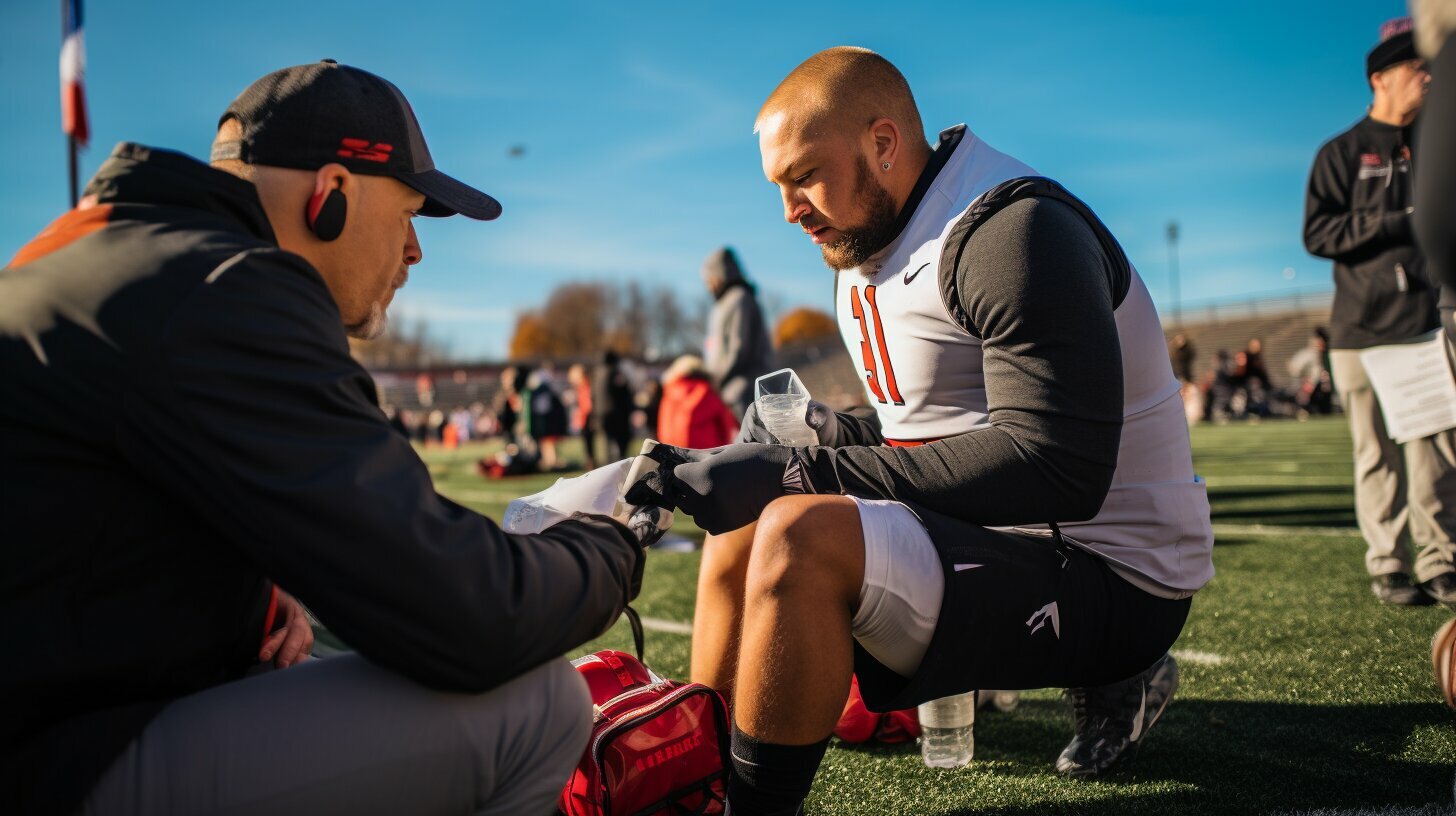
Regularly Checking and Replenishing the First Aid Kit
To maintain a well-stocked first aid kit, it is essential to regularly check and replenish its contents, ensuring that all medical supplies are up to date and easily accessible. Football is a physically demanding sport, and injuries are not uncommon. Having a well-stocked first aid kit on hand is crucial for providing immediate care and ensuring the safety of players.
Regularly checking the first aid kit allows you to identify any expired or depleted supplies that need to be replaced. This ensures that when an injury occurs, you have all the necessary medical supplies readily available. It is also important to regularly review and update the first aid kit contents based on the specific needs of your team.
Table: First Aid Kit Checklist
| Essential Items | Additional Items |
|---|---|
| Wound dressings | First aid guide |
| Bandages | Different sizes of bandages and dressings |
| Plasters | Wound closures |
| Tape | Zinc oxide tape |
| Gloves | Elastic adhesive bandages |
| Tweezers | Gauze swabs |
| Scissors | Clinical waste bag |
| Safety pins | Antiseptic cream |
| Wipes | |
| Foil blanket | |
| Instant ice pack |
By regularly checking and replenishing your first aid kit, you can ensure that you are fully prepared to address any injuries that may occur during football matches or training sessions. Prioritizing player safety with a well-stocked first aid kit is an investment in the well-being of your team.
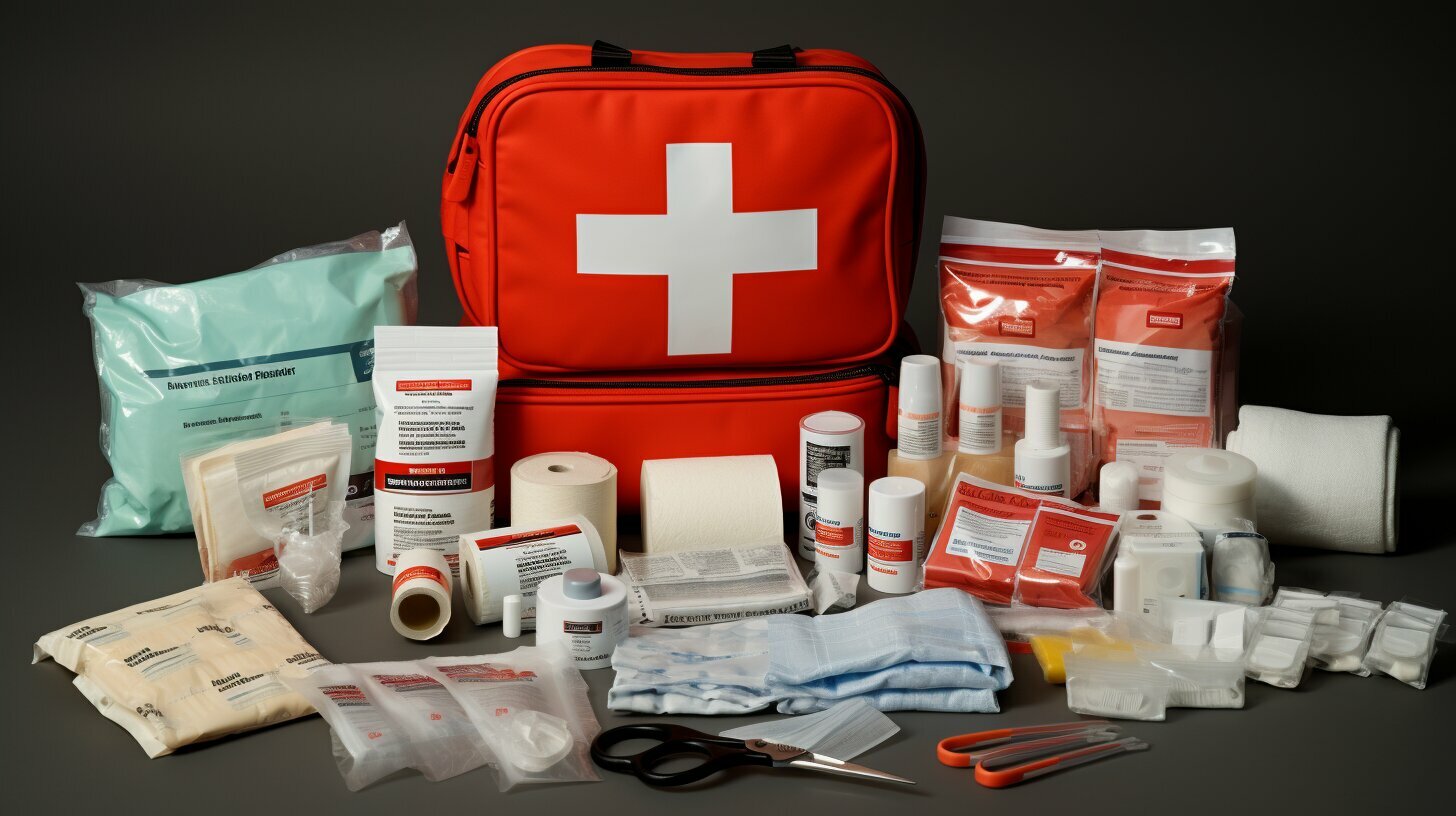
Customizing the First Aid Kit for the Team’s Needs
Every football team is unique, and it is crucial to customize the first aid kit to meet the specific needs of the players, taking into account any existing medical conditions or individual preferences. By tailoring the kit to the team’s requirements, coaches can ensure that they have the necessary supplies to address injuries effectively on the pitch.
When customizing the first aid kit, it is important to consider the most common injuries that occur within the team. For example, if sprains and strains are prevalent, it may be beneficial to stock up on elastic adhesive bandages and instant ice packs. If cuts and abrasions are more common, having a variety of wound dressings and antiseptic cream can be essential for proper treatment.
In addition, coaches should be mindful of any existing medical conditions that players may have. If a player has a known allergy, for instance, it is important to include the necessary medication or equipment to manage the condition in the first aid kit. By being prepared for these situations, coaches can provide prompt and appropriate care when needed.
Table: Customizing the Football First Aid Kit
| Item | Function |
|---|---|
| Wound dressings | To cover and protect cuts and abrasions |
| Elastic adhesive bandages | To stabilize sprains and strains |
| Instant ice packs | To reduce swelling and inflammation |
| Antiseptic cream | To prevent infection in wounds |
| Allergy medication | To manage known allergies |
By customizing the first aid kit to meet the team’s specific needs, coaches can ensure that they are well-prepared to handle any injuries that may occur during practices or games. Taking the time to evaluate the team’s requirements and regularly updating the kit with the necessary supplies will contribute to the overall safety and well-being of the players.
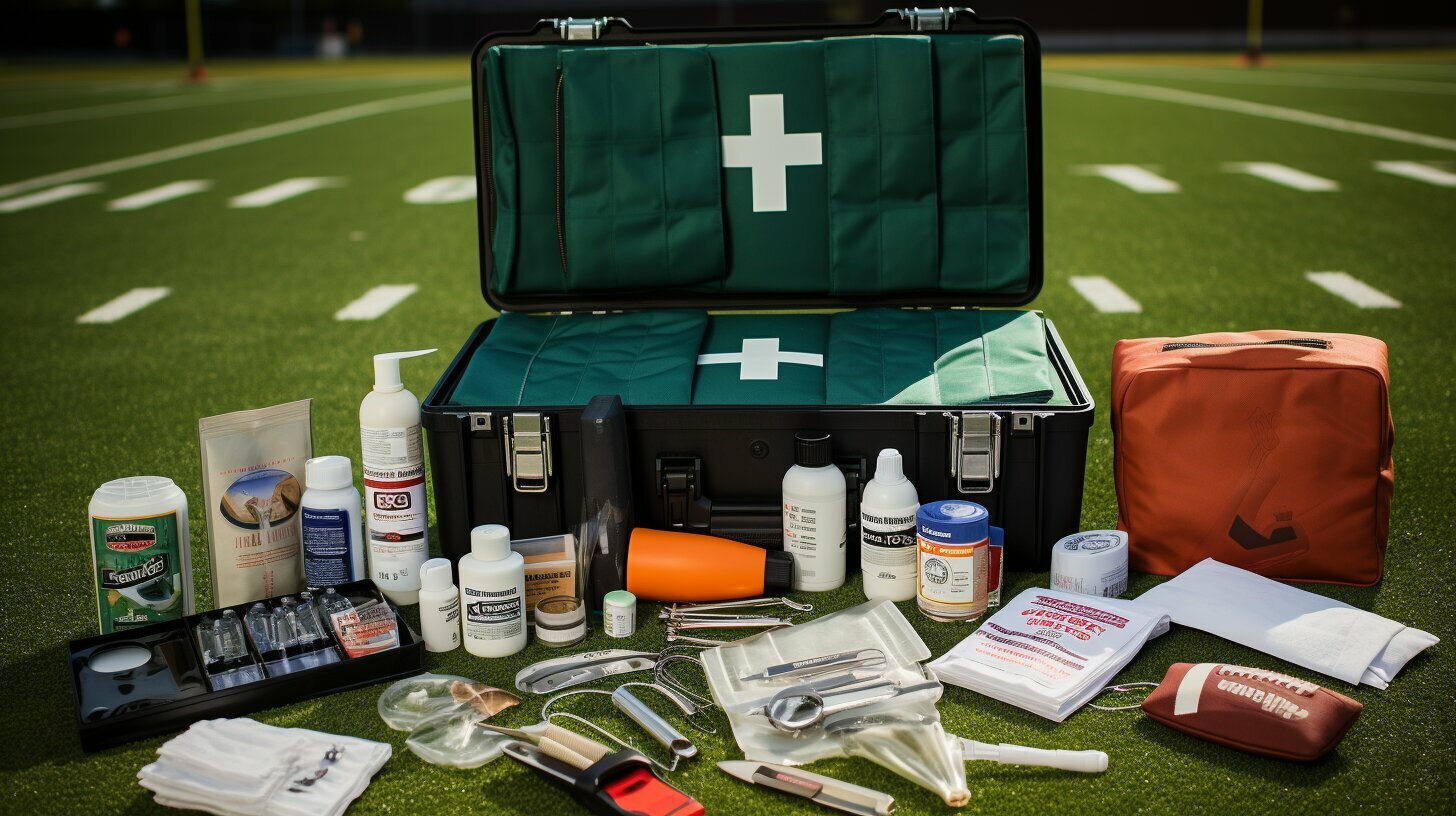
The first aid kit should always be readily accessible during football practices and games to ensure prompt and effective treatment of injuries. Designating responsible staff members is essential to maintain accessibility. In the event of an injury, quick access to the first aid kit can make all the difference in providing immediate care to the injured player.
To ensure the kit is easily accessible, it is advisable to have it located in a central and visible area, such as the team’s bench or sideline. This allows both coaches and medical personnel to quickly retrieve supplies when needed. It is also important to regularly check the kit to ensure that all necessary items are stocked, and expired or depleted supplies are promptly replaced.
In addition to keeping the first aid kit easily accessible, it is crucial to educate the team on its location and proper usage. Coaches should familiarize players with the contents of the kit and instruct them on basic first aid techniques. This knowledge can empower players to assist in case of an injury and ensure that the necessary supplies are used correctly.

| Item | Quantity |
|---|---|
| Wound dressings | 10 |
| Bandages | 20 |
| Plasters | 30 |
| Tape | 2 rolls |
| Gloves | 10 pairs |
| Tweezers | 1 |
| Scissors | 1 |
| Safety pins | 10 |
| Wipes | 20 |
| Foil blanket | 2 |
| Instant ice pack | 4 |
Essential Items for a Football First Aid Kit
- Wound dressings (10)
- Bandages (20)
- Plasters (30)
- Tape (2 rolls)
- Gloves (10 pairs)
- Tweezers (1)
- Scissors (1)
- Safety pins (10)
- Wipes (20)
- Foil blanket (2)
- Instant ice pack (4)
By following these tips and ensuring the first aid kit is easily accessible, coaches can swiftly respond to injuries and provide the necessary care to minimize the impact on players’ health and well-being.
Investing in Safety for Addressing Football Injuries
By investing in a well-stocked first aid kit and prioritizing safety, coaches can effectively address and manage common football injuries, ensuring the well-being and long-term success of their players. Football is a high-energy contact sport, and injuries on the pitch are a common occurrence. To keep players safe, it’s crucial to have a comprehensive first aid kit on hand at all times.
Common football injuries include concussions, sprains, strains, fractures, and cuts. These injuries can range from minor to severe, and it’s important to have the necessary medical supplies to provide immediate care. A well-stocked football first aid kit should include essential items such as wound dressings, bandages, plasters, tape, gloves, tweezers, scissors, safety pins, wipes, a foil blanket, and an instant ice pack.
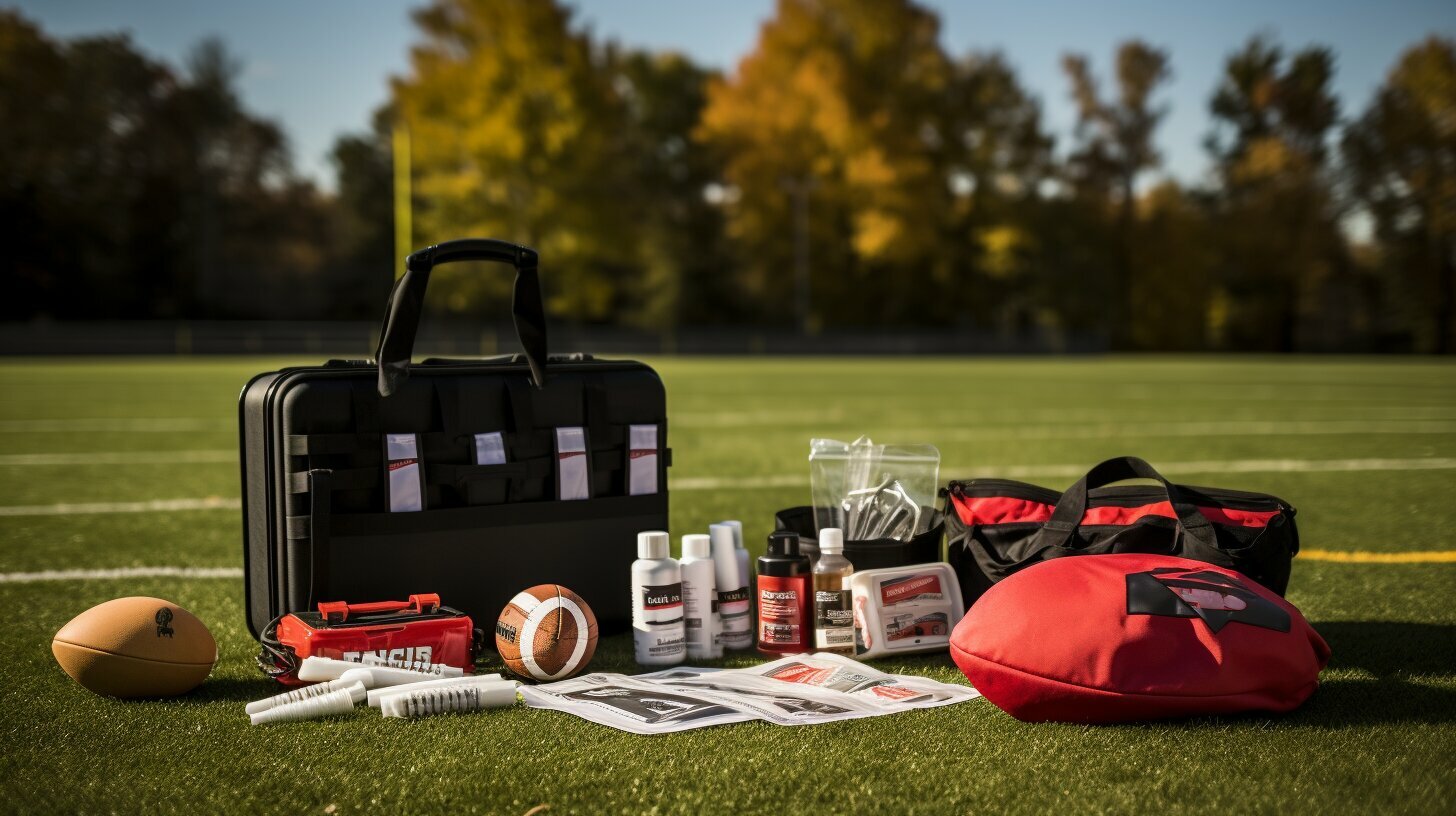
In addition to the basic supplies, it’s also beneficial to include additional items in the first aid kit. A first aid guide can provide step-by-step instructions for treating various injuries. Different sizes of bandages and dressings can accommodate different wounds. Wound closures, zinc oxide tape, elastic adhesive bandages, and gauze swabs are useful for more specific injuries. Furthermore, having a clinical waste bag and antiseptic cream ensures proper disposal of waste and hygiene maintenance.
Coaches should also prioritize educating themselves and their teams on injury prevention and basic first aid techniques. Regularly checking and replenishing the first aid kit is essential to ensure that all supplies are up to date and readily available when needed. Additionally, customizing the first aid kit to meet the specific needs of the team, taking into account individual player medical conditions and preferences, can further enhance player safety.
Lastly, keeping the first aid kit easily accessible during practices and games is crucial. Designating staff members responsible for the first aid kit ensures that it is always within reach when injuries occur. With a well-stocked first aid kit, proper education, regular maintenance, and accessibility, coaches can effectively address and manage common football injuries, promoting the well-being and long-term success of their players.
Conclusion
In conclusion, a well-stocked first aid kit is vital for addressing common football injuries and ensuring the safety of players. By prioritising safety, educating teams, and regularly maintaining the kit, coaches can create a secure environment and help prevent and manage football injuries effectively.
Football is a high-energy contact sport, and injuries on the pitch are common. To ensure the safety of players, it’s important to have a well-stocked football first aid kit on hand. This kit should include essential items such as wound dressings, bandages, tape, gloves, scissors, and an instant ice pack. It’s also beneficial to have additional items like a first aid guide, different sizes of bandages, wound closures, and antiseptic cream.
In addition to having a well-equipped first aid kit, coaches should emphasise injury prevention by encouraging players to warm up and cool down before and after matches. These exercises can help reduce the risk of injuries like sprains, strains, and fractures. Coaches should also educate themselves and their teams on injury prevention and basic first aid techniques, ensuring that everyone is prepared to respond in case of an injury.
Regularly checking and replenishing the first aid kit is crucial to ensure that all supplies are up to date and readily available. Coaches should customise the kit based on the specific needs of the team, considering individual player medical conditions and preferences. It’s also important to keep the kit easily accessible during practices and games, with designated staff members responsible for its management.
By investing in a well-stocked first aid kit and prioritising safety, coaches can create a secure environment where players can enjoy football while minimizing the risk of injuries. The long-term benefits of prioritising player safety are invaluable, ensuring that everyone can fully participate in the sport they love while staying safe and protected.
